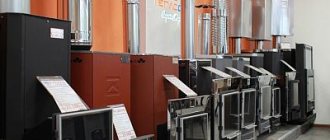One of the most difficult issues in equipping a bathhouse is selecting a stove for it.
You should not rely only on aesthetic characteristics, because the technical characteristics of the equipment play a much larger role. One of the key parameters is the power of the unit, because the optimal heating area depends on it.
It is also desirable that the stove has a container for heating water.
There are other criteria that you should pay attention to when choosing.
They are listed below. Guided by this checklist, every bathhouse owner will be able to choose the right equipment, and the rating of the best models according to the 2022 version in terms of price/quality ratio will help you finally make your choice.
Rating of the TOP 12 best stoves for saunas with a tank in 2022
| Place | Name | Price |
| TOP 4 best sauna stoves with a tank by price/quality for 2022 | ||
| 1 | Harvia M3 SL | Find out the price |
| 2 | TMF Biryusa 2013 Carbon anthracite | Find out the price |
| 3 | Harvia 20SL | Find out the price |
| 4 | Teplodar Sahara 10 LB/LBU | Find out the price |
| TOP 4 best stoves for a wood-burning sauna with a tank | ||
| 1 | Vesuvius Rusich Aqua 22 (DT-4) with 61l tank | Find out the price |
| 2 | Birch Favorite 24 | Find out the price |
| 3 | Vesuvius Rusich Aqua 16 (DT-4) with 49l tank | Find out the price |
| 4 | TMF Skoroparka 2022 Inox Vitra B | Find out the price |
| TOP 4 best inexpensive sauna stoves with a tank | ||
| 1 | Konvetika Konvetika 12B | Find out the price |
| 2 | TMF Tunguska 2022 Inox DN TO anthracite | Find out the price |
| 3 | Varvara Palenica Wall mounted shortened firebox | Find out the price |
| 4 | TMF Biryusa 2013 Inox Vitra ZK | Find out the price |
Questions and answers
Heating water is a multivariate procedure. Inexperienced users often have questions that need to be answered experimentally. There may be errors that require you to redo the entire work from the very beginning. Therefore, it would be wise to answer the most frequently asked questions in advance and reduce the time it takes to create a heating system.
Which hot water tank is better, a large one or a smaller one?
A large tank allows you to save hot water, but heating it is more difficult and takes longer. As a rule, for a private family bath, choose a tank capacity of no more than 100 liters - otherwise you will have to wait too long for the water to reach the desired temperature.
What is more profitable, a separate heating device, or heating from a stove?
Preparing water in a container on a stove is more economical if its power is sufficient to heat the room and water. However, if the stove is small and was initially chosen only for heating the room, you will have to use an independent heating device. All things being equal, heating water using only a stove is much more economical in every respect.
What is better, making a tank yourself, or purchasing a ready-made one?
In any case, a homemade tank will cost many times less. The only condition will be the availability of suitable material, equipment, as well as the ability to work with all these accessories. If you don’t have the skills, it’s better to buy a ready-made tank and save yourself the loss of time and materials.
How long does it take to raise the water temperature to standard 80 °C using a heat exchanger?
The duration of heating depends on the size of the container and the performance of the heat exchanger. On average, it takes 1.5-2 hours to prepare water, but deviations in one direction or another are possible.
What to do if the performance of the water treatment system is not enough?
There are two ways to solve the problem here. Or remake the entire system taking into account existing shortcomings and increase its performance to the required level. Or install an additional heater that can compensate for the shortcomings of the main system. The second option may be even more effective, since a separate heater can be connected to a specific group of consumers (for example, showers).
How to choose a stove for a sauna with a tank?
To make visiting the bathhouse comfortable, you should choose the right stove with a tank.
The main selection criteria are:
- Case material . Most manufacturers make stoves from high-strength steel. It is resistant to mechanical damage and practically does not heat up during operation, which completely eliminates the risk of accidental burns.
- Fuel type . Sauna stoves can be powered by gas or solid fuel. It is advisable to choose models that operate on combined fuel, as this will significantly expand the operational capabilities of the device.
- Power . Each stove model is designed to heat a room of a certain area. There is no point in saving on this criterion, because if the device operates at its maximum capacity, the room will not warm up completely. It is advisable to choose equipment a little more powerful than intended for the steam room.
It is also advisable to pay attention to the shape of the firebox removal, especially if the stove will be fired from an adjacent room. In this case, it is better to choose a device with a straight firebox, because it will be much easier to install.
Methods of heating water in a bath
Connecting to centralized water supply systems is a rare luxury that is not available to every bathhouse owner. Therefore, you have to solve the problem yourself.
There are two main ways to do this:
heating water using a sauna stove;
use of specialized heating installations.
The first option is good if the stove is equipped accordingly, or allows you to install containers for heating water. At the same time, the furnace will require greater load and, accordingly, increased fuel consumption.
Heating water from a sauna stove
The principle of operation is simple - cold water is supplied to a container installed above the furnace firebox. From the heat of the stove, it heats up and goes to water collection devices (faucets, showers, etc.). When the water level in the tank drops to a critical level, the volume is replenished manually or automatically using a conventional float valve.
This is the simplest, but also the longest heating method - if the tank has a large capacity, you will have to wait until the water temperature rises to the desired level.
In addition, there is another problem - the water sooner or later boils and begins to release a large amount of steam. The only way to stop the process is to stop heating the stove, which can cause the temperature in the bathhouse to drop.
However, this is not the only way. There are different options for implementing heating using a sauna stove. You can install a storage tank in the washing compartment, and install a small-volume register tank in the stove (there is another option, when the register tank is installed as the first section of the chimney, where the heating of the flue gases is maximum).
Sometimes a container of water is installed close to the side wall of the stove, or mounted in the chimney duct (inside or around it). Typically, these options are ways to adapt an existing furnace to heat water. The choice of the appropriate option is determined by the configuration, size and location of the furnace.
Separate heaters
Independent heaters are not related to the sauna stove and do not increase the load on it. However, they are quite expensive and consume resources - gas, firewood, electricity.
An example of such a device is a geyser, to which cold water is supplied for heating and supply to water collection points. It can be connected to a centralized gas supply system, or switched to powered by liquefied gas (in cylinders). In this case, the bathhouse becomes practically autonomous, almost independent of external resources.
Most users consider this option the most effective and economical - gas heaters provide the fastest and relatively cheapest water heating.
Electric heaters have a noticeable advantage - they only require a connection to the power supply.
However, a large amount of energy is consumed to prepare water - in regions with expensive tariffs, using heaters on heating elements is too wasteful. This option is usually chosen for baths that are used only periodically.
Heat exchanger
This is a compromise option for preparing hot water. It uses the thermal energy of the furnace, but acts as an intermediary. From a design point of view, this is a specific type of heater that uses an indirect method of transferring thermal energy.
A small tank of water with a volume of about 5 liters is installed above the stove (or in the hottest part of the building). A cold water coil passes through it. During the passage, the water heats up and leaves the tank already hot. At the same time, too much power is not required from the stove, and fuel consumption does not increase.
Expert opinion
Lovkachev Boris Petrovich
Bath master who knows everything about steaming
The option is effective and economical, but requires high-quality adjustment of the heat transfer mode, as well as starting circulation - water must move along the coil so that heated portions are replaced by cold ones.
There are designs with natural circulation - heated layers of water rise upward and are replaced by colder ones rising from below. However, it is difficult to rely on natural circulation - if even small errors are made when installing the containers, the circulation may be too weak or completely absent.
The main advantage of the heat exchanger is the isolation of the main tank - it is usually removed to another room. The water in it does not boil and does not fill the room with moist steam, which allows for a more favorable microclimate. However, there are simpler designs when the coil is installed on a chimney.
The water is heated from the high temperature of the flue gases. Under normal conditions, it is wasted, but installing a coil allows you to rationally use it and heat water. The only condition is a single-layer pipe design. Typically, the coil is placed under an outer casing to reduce heat loss.
Pyrolysis boilers
The most innovative are the most perfect modifications of long-burning boilers. Let's look at the differences. First of all, in terms of cost, the price of such equipment is beyond the means of many.
There are a large number of different automation installed, but unfortunately there is very little real benefit from it.
- In addition, a large number of installed auxiliary equipment makes it likely that some part will definitely fail.
- A pyrolysis boiler differs from a continuous combustion boiler, namely, a slightly increased coefficient of the desired effect.
- The gases released during the period of slow burning or smoldering of firewood burn out in a special hydrolysis section.
Pre-heated air space enters it through special passages and gases that contain flammable compounds burn out in an additional chamber.
Manufacturing options
There are several basic options for making sauna boilers with your own hands. Drawings of the device must be made as accurate as possible to avoid various errors during assembly.
From a metal pipe
This method of creating a boiler is considered the most popular and most used. Most often, thick-walled metal pipes are used as the main material. It is best to use blanks with a diameter of at least 50 cm and a length of approximately 1 m. With their help, you will get a device capable of heating a steam room with an area of 9 square meters.
The boiler manufacturing process is simple and consists of the following steps:
- Three identical pieces with a diameter of 1.4 cm and a length of 30 mm are cut from the reinforcement. These parts will be used as supports for the body of the product.
- A circle (the bottom of the future device) of the same diameter as the pipe is cut out of a sheet of steel.
- A metal lid for the stove is cut from a piece of material.
- A hole is made in the middle. Its size must exactly match the diameter of the chimney.
- A hole is formed at the bottom of the pipe.
- Then the box is made. A separating part should be provided inside it, which will form two chambers: for the firebox and for the ash.
- At the next stage of work, the assembly of the structure begins. First of all, the manufactured box is welded, which should go outside or into the combustion chamber.
- The chimney pipe is inserted into the pre-made hole.
- Then the foundation for the furnace is equipped. It can be a concrete screed or a reinforced concrete slab.
- The device is installed on it, and heavy stones are placed on top of the lid.
- At the very end, a brick heat shield is built. You can make it in the form of a small wall or cover the entire boiler.
From sheets of metal
This manufacturing option is distinguished by its simplicity and accessibility. The work uses inexpensive sheet steel with a diameter of 5 and 10 mm, as well as some materials that can be bought at any hardware store in the city.
Procedure:
A drawing of the future product is drawn with a detailed representation of the most important components. Separate blanks of the required size are cut from purchased sheets of metal. Moreover, they must exactly correspond to the manufactured diagram of the sauna boiler. A piece of thick-walled material is folded over and forms the body of the device. The edges are then welded to each other
It is important to make the seam as smooth and high quality as possible. If there are no opportunities or skills to carry out such work, then it is best to hire a qualified specialist. A piece of pipe is welded into the inside of the manufactured body. Then a water tank is formed. A wide hole is made in the combustion chamber and a chimney pipe is installed into it. A special valve is attached to it, which will control the traction force. A combustion door is attached to the structure. A small tube for connecting a tap is attached to the back of the boiler. A protective brick screen is built around the device
Thanks to it, the negative impact of high temperatures on people will be reduced. In addition, it will protect against accidental touch and severe burns.











